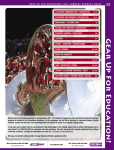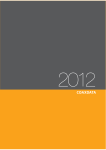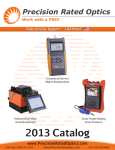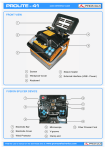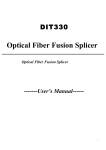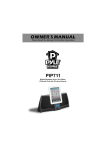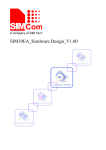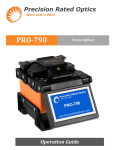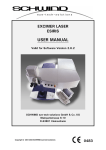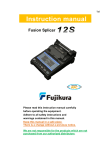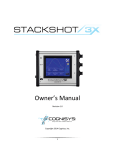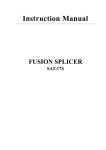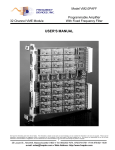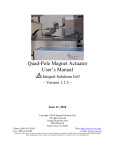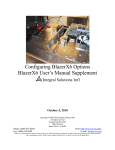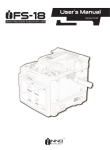Download FIBER FUSION SPLICER
Transcript
User Manual MW5200/M FIBER FUSION SPLICER MW5200/M OPERATION MANUAL 1 User Manual MW5200/M Contents 1. Notice before using ......................................................... 1 1.1. Safety instruction ........................................................ 1 1.2. Note ............................................................................. 2 1.3. Legal statement ........................................................... 3 2. Start to comprehend splicer .......................................... 4 2.1. Overview of splicer ..................................................... 4 2.2. Key .............................................................................. 5 2.3. Technical parameters ................................................... 9 2.4. Tools configuration .................................................... 11 3. A complete splice .......................................................... 12 3.1. Power on ................................................................... 12 3.2. Preparation of fiber end face ..................................... 13 3.3. Fiber clamping .......................................................... 15 3.4. Optical fiber fusion ................................................... 17 3.5. Heat-shrinkable ......................................................... 18 3.6. Cooling ...................................................................... 19 4. Menu instruction .......................................................... 19 4.1. Parameter setting menu ............................................. 21 4.2. Setup ......................................................................... 24 4.3. Function .................................................................... 29 2 User Manual MW5200/M 4.4. Maintenance .............................................................. 33 4.5. Heater ........................................................................ 38 4.6. Electrodes .................................................................. 40 4.7. Status ......................................................................... 43 4.8. Information................................................................ 44 5. Routine maintenance ................................................... 45 5.1. Cleaning .................................................................... 45 5.2. Replacing electrode ................................................... 48 5.3. Electrode aging ......................................................... 50 5.4. Software upgrade ...................................................... 51 6. Common fault and solution ......................................... 52 7. Appendix A ................................................................... 54 3 1. Notice before using 1.1. Safety instruction Please read the following information before first using. 1. Use the specified battery and adaptor, otherwise it may cause an explosion or permanent damage of the machine. 2. Don't use the machine in high temperature, flammable and explosive environment (such as a gas station nearby). 3. Don't attempt to disassemble the machine and its accessories, only authorized agencies can repair the machine. 4. Please don't contact electrode rods in working condition, or it may cause personal injury. 5. When there are liquid, foreign matter into the machine, or a smoke, odor, noise, etc., or the machine is strong impact, please immediately shut down the machine, and pull out the AC power. 1 1.2. Note When using the machine, improper operation may result in machine damage or human health. It is suggested to use the machine in the following way. 1. This type of machine is only used for splicing quartz glass fiber, not in place of any other matter. 2. Don't use or storage of the machine in high temperature or humidity environment (otherwise it may damage the equipment or cause machine performance degradation). 3. While using the machine in the dust environment, please avoid the dust as far as possible. 4. When moving the machine from the low temperature environment to the high temperature environment, there should be any heating process to eliminate condensation. 5. Please use high-purity anhydrous alcohol (purity>99%) to clean magnifying lens, reflector and Fiber V-groove surface. 6. The splicing machine must be handled gently to avoid strong vibration and impact, use with carrying case for transportation and storage. 7. The machine maintenance once a year. 2 1.3. Legal statement Without written consent of our company, any unit or individual will not be allowed to extract or copy part of the contents of this manual, or transmitted in any form. Products described in this manual, including our company software, unless approved by the related oblige, otherwise no one can be in any form for the software to copy, distribute, modify, excerpts, decompiling, disassembling, decryption, reverse engineering, lease, transfer, sublicense and other ACTS of infringing the software copyright. Attention: The manual describes some features and functions of the product and its accessories, related to the production batch, therefore, description in this manual may not exactly match the product you purchased, as well as its accessories. Our Company reserves the right to modify any information in this manual at any time, without any prior notice and does not undertake any responsibility. Limitation of liability: Within the scope of applicable law, our company, in any case, don’t compensate for any special, incidental, indirect, secondary damage due to using this manual or the product, and also don’t compensate for any loss of profits, data, goodwill or anticipated savings. Within the scope of applicable law, in any case, our 3 company will undertake the greatest responsibility for the losses suffered in use of the product described in this manual in limit of the price you paid for the product. (Except in cases involving of personal injury according to applicable law for damages) 2. Start to comprehend splicer 2.1. Overview of splicer Figure 2.1 4 2.2. Key 2.2.1. Key appearance Figure2.2 Table 2.1 1 Power 2 Enter 3 Menu / Exit 4 Up 5 Left 6 Down 7 Right 8 Heat 9 Arc 10 Reset 11 Switch video 12 Auto splice 5 2.2.2. Key function Table 2.2 z While Power On, press this key to shut down. z While Power OFF, press this key to Power On. z Under standby interface, press this key to discharge weak arc. z In menu, press this key to enter the next submenu. z If permitted, press this key to run. z If permitted, press this key to switch between the left and right sides of CMOS Sensor, Motors and so on. z Under standby interface, press this key to enter main menu. z Under the main menu interface, press this key to return the upper menu. 6 z Under standby interface, press this key to increase the LCD backlight. z In CMOS sensor step, press this key to increase the CMOS sensor backlight. z In motor adjustment, press this key to drive up the fiber. z If permitted, press this key to move up the cursor. z Under standby interface, press this key to gap the fiber. z Under the main menu, press this key to select the left icon. z In motor adjustment, press this key to drive the corresponding motor move to left. z Under standby interface, press this key to decrease the LCD backlight. z In setup of CMOS sensor, press this key to decrease the CMOS sensor backlight. z In function of motor test, press this key to move down the 7 corresponding motor. z If permitted, press this key to move down the cursor. z Under standby interface, press this key to align the fiber. z Under the main menu, press this key to select the right icon. z In motor adjustment, press this key to drive the corresponding motor move to right. z Under standby interface, press this key to fuse. z In Power On state, press this key to reset motor position. z Under standby interface, press this key to switch video mode. z Under standby interface, press this key to run auto splice. 8 2.3. Technical parameters Table 2.3 Fitted fiber SM,MM,DS,NZDS Cladding diameter 80 -150um Coating diameter 100 - 1000um Typical loss SM:<=0.02dB; MM:<=0.01dB; DS:<=0.04dB; NZDS:<= 0.04dB Echo loss Cutting length > 60dB 10~16mm(Coating layer Diameter:< 250µm) Program 40 groups Operation mode Auto mode and Manual mode Auto to heat Supported Splice time 7 seconds Heating time 30 seconds(heat-shrinking tube width is 40mm or 60mm) Magnification 150 times/double show,300 times/single 9 Observation mode High sensitivity CMOS sensor, Color LCD of 5.6 inch with pixels 640x480 Fusion Records Support to store 4000 groups of Fusion Records Estimate loss Supported Tension Supported,2N Operation GUI Interface Battery capacity Power supply 10.8Ah;Typical 220 times fusion; Show remaining real-time Adapter : AC100-240V(50/60HZ); Output : DC11~13.5V Electrodes times 4000 times Interface 12V DC power input,USB2.0 Operation Altitude:0~5000m;Humidity:0~95%; Enviroment Temp:-10℃~+50℃;Air speed:<=15m/s Volume/weight 160mm(L)×150mm(W)×145mm(H) /2.8kg(Battery Included) 10 2.4. Tools configuration Table 2.4 Carrying Case: ¾ Keep the splicer away from the bumping and compact ¾ Working platform Fiber Cleaver: ¾ Cutting fiber ¾ Preparation of the fiber end face Spare electrodes: ¾ Replace the aging electrodes Strip clamp: ¾ Stripping the fiber coating Alcohol pump bottle: ¾ Used to hold alcohol 11 Cooling tray: hold heat shrink tube to cool AC-DC Adapter for splicer 3. A complete splice A full fiber splice procedure including: the fiber end face preparation, fiber splicing, tension test, heating and cooling of shrink tube. This chapter will introduce details of the specific process of the fiber splice. 3.1. Power on Figure 3.1 Press and hold the power button until the power indicator 12 light, then, LCD also enter the self-test screen. 3.2. Preparation of fiber end face Prepare two optical fibers, as shown in Figure 3.2, which an optical fiber is set into the heat shrink tube. Figure 3.2 As shown in Figure 3.3, clenched fiber cleaver, place the fiber into the tooth of clamp by the left hand, reserve bare fiber 30 to 40 mm stripped fiber coating. Use a cotton ball dipped in anhydrous alcohol (purity>99%) wipe optical fiber coating layer that residual debris, Figure 3.4 shows. 13 Figure 3.3 Put the cleaned fiber into the cutter positioning groove, the edge alignment of the fiber coating cutter ruler “13” scale outside (the scale is greater than 13, shown in Figure 3.4). Close small platen, requiring that the bare fiber straight on the left and right rubber on the chopping block. Together close the large plate, and push the cutter blade slider to the other end to cut off the fiber. After Cutting, open the large platen to take away cutting broken fiber into the waste fiber storage box. (Broken fiber has a great harm to human health, so, please be sure to collect and chop broken fiber). Open the small platen, and carefully take out the cut end face fiber. Don’t make the fiber cross section touching any other objects, in order to avoid damage or contamination end face. 14 Figure 3.4 3.3. Fiber clamping Open the windproof cover and the two side fiber platens, then, put the prepared fiber into V-groove through the locating slot. Make sure that the fiber end face should be located between V-groove edge and two electrodes. Shown in Figure 3.5 15 Figure 3.5 Please operate carefully and don’t let the fiber end face touch any other object. Then close the large platen to fix optical fiber, which should be placed horizontally in the V-groove, without upturned phenomenon. If clamping failed, you can lift fiber carefully and repeat the operation above until the fiber clamping is qualified. Similarly, prepare and clamp the other optical fiber. Then, close the windproof and continue to observe the amplified fiber from the display. If the fiber end face is obviously uneven, tilt or damaged, you need to remove the fiber to cut again. 16 3.4. Optical fiber fusion After clamping, the machine is in ready state, as shown below. If in "Automatic" splice mode, auto splice begins as soon as the windproof closed. If in "Manual" splice mode, user must press the "SET" button to run the splice routine. Figure 3.6 First, select fusion parameter group according to the optical fiber type. Press “MENU” to enter the main menu, and then select the “parameters” icon and press the “confirm” key to enter the menu. We need to select fusion parameter group matched with splice fiber type. It is suggested to choose the automatic splice parameter group for new users. Press "SET" to start the splice procedure. The machine 17 drives the motor, which will promote both sides of fibers to the middle of the screen, judging the fiber end face whether meet the requirements. If qualified, turn to the next process, otherwise show a tip of bad end face and stop. After judgment, alignment motor will adjust fiber position to make both sides of fibers align in three-dimensional. At last, the electrode discharge arc to fuse fiber. When fusion completed, the machine will give the loss estimates, and have a tension test if needed. 3.5. Heat-shrinkable Optical fiber fusion point is really fragile and easily broken, so, you need protection by using heat shrinkable. Open the windproof cover, large platen and heater cover. Gently remove fiber, and don’t bend fiber greatly to avoid the fusion point broken. Move heat shrinkable tubing to the fusion point, which must be in the middle. Then, place heat shrinkable tubing in the middle of the heating furnace. The heater begins heating as soon as heating furnace closed. About 30 seconds later, heating shrinking has completed. The figure below is the heat shrink tubing before thermal shrinkage and after thermal shrinkage. 18 Figure 3.7 3.6. Cooling The heat shrinkable tubing after heating is in high temperature, and need cooling. Hang the cooling tray on the carrying handle. So, after heating, pull out the fiber from the heating furnace to the cooling tray by hands. About 1 minute later, it cools to the ordinary temperature. 4. Menu instruction The machine adopts METRO-style menu, whose interface is simple, beautiful and convenience for operation. The operation interface has 8 icons, and each icon corresponds to different functional menu. 19 Figure 4.1 For the main menu interface: In standby state, press the key main menu. to enter interface of In the main menu, press the key to exit the main menu to standby interface. In the main menu, press the direction keys, and the corresponding direction on the next icon is selected. Press the key to enter the submenu. In submenu: 20 Press the key or to select the up down cursor. Press the key or Press the key to enter the next submenu. Press the key to enter the upper menu. to modify the current data. 4.1. Parameter setting menu Figure 4.2 "Parameters" menu is used to select and set the fiber splicing parameters. Menu forms by different splicing parameters submenu, as shown in Figure 4.2. Each sub-menu is a group of splicing parameters, and the menu is composed by the part of the number, file name, pattern 21 and state. Number from 0 to 39, a total of 40 groups of parameters can be used. Mode Auto, Calibrate, Normal three kinds, of which the Auto class of parameters derived experimental optimization for the factory and cannot be modified and recommended for new users. The data of the Calibrate parameters can be modified except the pre-discharge and post-discharge time. All the Normal parameters can be modified. Figure 4.3 The “type” represent which the fiber is fused by the parameter. Abbreviations are explained in the following. SM: Single mode fiber MM: Multi mode fiber DS: Dispersion shifted fiber 22 NZDS: Non-zero dispersion-shifted fiber The state ON/OFF says the group is currently used or not. Press the key or to change the current splicing parameter group. Press the key to enter the para group, as shown above. The parameter consists of the following parameters: Prefuse time Prefuse time in total fusion process, a short time about 10ms. It is not recommended for the new user to modify. Fuse time Fuse time in total fusion process, a long time more than 1 second. It is not recommended for the new user to modify. Arc Discharge current means that the discharge arc current intensity. The high value of the current corresponds to a greater arc, resulting in a higher temperature. The fiber is ablated more seriously. Press the key increase or decrease the parameter value. or to Pushing overlap The pushing forward distance in fusion process. Press the key or to add or sub the value of overlap. Gapping The distance of fiber gap before fusing. Press the key or to change it. Max end face The angle between the fiber end and vertical 23 direction is the end face. In the process of judging the fiber end face, the fiber end face should not more than the Max end face. State It shows the using state of the current viewing parameter group. You can press the key change the parameter. or to 4.2. Setup The “setup” menu is used to set the data including the operation mode, language, camera brightness, tension and auto shutdown, as shown below. Figure 4.4 24 4.2.1. Operation mode The operation mode is the method of machine fusion, consists of: automatic or manual mode. This parameter, automatically, turn off the windshield in the standby inter face, the splicing machine will begin running splice fiber optic procedures. Manual mode requires user to press the "SET" button, and the machine will begin splicing optical fiber. Select the menu button, and press the key , the parameter values will switch between "automatic" and "manual". Suspend 1 When fiber splicing, fiber advancing to meet the gap conditions, the program pauses, waiting for the further operation of the user. For continue to splicing, press "SET" button. To interrupt splicing, press the "RESET" button. Suspend 2 Fiber suspend the running at the end of the subsequent process of aligning. Reset time After a fiber splicing, in order to prepare for the next splice, propulsion motors need to be reset to the reference position. Fiber splicing completed, open the windscreen, over a period of time to wait for propulsion motors begin to reset. The waiting is the time that automatically reset. The menu selected, press the key 25 or to change the parameter values. Figure 4.5 26 4.2.2. Language Language shows the display language current software used. There are two languages available: ¾ Chinese The software interface displays Chinese. ¾ English The software interface displays English. Figure 4.6 27 4.2.3. Camera brightness Press the key to enter the interface of camera brightness, as shown below. Press the key or to modify the gain of CMOS camera resulting in the change of camera brightness. Press the key CMOS camera sensor between X and Y. to switch the Figure 4.7 4.2.4. Tension Open the option, splice completed, the machine would impose 2 Newton’s pulling on the fiber to test the quality of splicing. If the fiber broken, it means the fusion failure. Press the key and OFF. to switch the tension state between ON 28 4.2.5. Auto shutdown When the option turned on, the machine will shut down automatically if no operation within ten minutes. 4.3. Function The function menu lists the splicing machine with some features, such as time and date, motor test, export splicing records, program upgrade, ect. as shown in Figure 4.8. Figure 4.8 29 4.3.1. Date and time Press the key to enter the interface of Date and Time as shown in figure 4.9. Press the key or to move the selection cursor, and then press the key modify the selection value. Figure 4.9 30 or to 4.3.2. Motor test Motor test imitates the distance of the push motor moving forward in the fusion process. Press the key to enter the interface. After the prepared fiber clamped into the machine, you must press the key to run the test. The test results will be given at the end of the test, as shown in Figure 4.10, which shows the distance of each push motor moving forward. Figure 4.10 31 4.3.3. Export records The option is used to export the fusion records memories in the machine. After the U disk inserted into the USB port, choose this option and press the key to confirm fusion records export. As Figure 4.11 shown, program begins to test USB port and then find the records. If there’s no record, program will prompt error. Figure 4.11 32 4.3.4. Software upgrade This function is used to upgrade software in the machine. After the U disk with upgrade file inserted into USB port, choose this option and press the key to upgrade. As shown in Figure 4.12, program begins upgrading. Attention that after upgraded, users need to boot. Figure 4.12 4.4. Maintenance The Maintenance menu consists of Electrodes Aging, 33 Motor Checking, Fusion Records, Arc Numbers, etc, as shown in Figure 4.13. Figure 4.13 4.4.1. Electrodes aging New electrode discharge instability and the need for the discharge of a certain number of times to stabilize the arc which called electrode aging. 34 When electrode replaced, enter this menu and then press the key to start aging the electrode, as shown in Figure 4.14. Don’t open windproof cover in aging process. Figure 4.14 4.4.2. Motor checking Motor checking is used to check the motor performance and change the motor position. Total of 4 motors are available for operation. 35 Figure 4.15 Press the key to enter the video interface. Press the key to switch the left and right motors. The align motor will move up or down by pressing the key or motor will drive left or right by pressing the key 36 . The push or . 4.4.3. Fusion records Figure 4.16 This option stores working parameters, fiber end face, the environment and date in each splicing. The machine can store 4000 groups of fusion records. The key can be pressed to enter the page of fusion record, and the page displays ten groups of fusion records, sequence from top to bottom by the latest fusion time as shown above. Press the key or to the contiguous page. Press the key enter the page of fusion records. 37 to Figure 4.17 4.4.4. Discharge records This option shows the total number of discharge. 4.5. Heater The Heater menu is used to set heating time and heating mode, as shown in Figure 4.18. Heater mode includes two kinds, automatic mode and manual mode. In automatic mode, after the heater the heat shrink tubing loaded and the cover closed, the program begins heating automatically. In manual mode, users need to press the key “HEAT” to begin heating after the heater cover closed. 38 Heat time needs to set by users according to specific heat shrinkable. Select this option “Heat Time”, and press the key or to change the time. Select the option “Auto Heat”, and press the key or to change the mode. Figure 4.18 39 4.6. Electrodes Electrodes menu is used to view and calibrate the arc degree. The electrodes discharge arc without motor pushing forward when the fiber is ready for fusion. The fiber is burned into the shape of arc, and the shortest distance of the shape of arc reflects the electrodes arc degree. In general, the shortest distance 9mm to 12mm (Standard distance) will get loss less than 0.02db. Figure 4.19 40 4.6.1. Arc adjust Select this option into the video interface, as shown in Figure 4.20. Cut and clamp fiber according to splice procedure, and then press the key . The calibration program starts to run and test results are given. According to the test results, manually set the splicing parameters of discharge current, and repeat the above steps until the test results meet the requirements. Figure 4.20 41 4.6.2. Arc calibrate Automatic calibration can automatically change the fusion parameters in the discharge current until the test results meet the requirements on the basis of test results. The test interface is shown in Figure 4.21. Figure 4.21 42 4.7. Status Status menu gives the atmospheric pressure, the internal temperature, the ambient temperature and the remaining power, as shown in Figure 4.22. Figure 4.22 43 4.8. Information In Information menu, users can inquiry the serial number of the machine and software version information, as shown in Figure 4.23 below. Figure 4.23 44 5. Routine maintenance 5.1. Cleaning 5.1.1. Cleaning V groove V-groove is a V slot on the ceramic substrate of narrow width, easily to accumulate dust which will make the fiber move instability and cause a bad fusion, therefore, the V groove should be cleaned regularly. The following is the way of cleaning the V groove: 1. Place the fiber with good enface into the V groove to remove the pollution, shown in figure 5.1. Figure 5.1 45 2. Use a cotton swab soaked with alcohol to clean the surface and bottom of the V groove. At last, the alcohol should be the natural air-dry or wiped dry by the dry cotton swab. Shown in figure 5.2. Figure 5.2 5.1.2. Cleaning fiber presser foot The dust accumulated on the fiber press foot will cause the pressure instability and affect the quality of fusion. So, it should be wiped off from the fiber pressure foot regularly. Open the windproof cover, and then use the cotton dipped in alcohol to clean the surface of the presser foot. When cleaning, don’t repeat back and forth with cotton, but to wipe the foot in one direction. Besides, users need to spin the cotton swabs, keeping the unused cotton facing the presser foot, waiting for the alcohol volatile. 46 5.1.3. Cleaning reflector Figure 5.3 When the reflector accumulated with dust, the fiber imaging through the reflector will fuzzy and in incorrect position as a result of bad fusion loss, so the dust should be wiped off from the reflector regularly. When cleaning, with reference of the below graphic, from the center to the edge of the reflector, user should rotate the cotton ball dipped in alcohol to clear repeatedly until the reflector is of neat and tidy. 5.1.4. Cleaning objective lens Microscope is the core component of the machine optical 47 system. So its surface must be kept clean, and users should regularly clean. The microscope is cleaned by the swab which dipped in a little alcohol, with a spiral movement from the center to the edge of the lens and the rotation around the swab until to spin out the edge of the lens. Figure 5.4 5.2. Replacing electrode Arc produces by high temperature, melting the fiber, which will produce silicon oxide vapour and some deposited on the electrodes, causing the arc instability. Therefore, users are recommended to replace electrodes when discharge reached 2500 times. Please replace the electrodes according to the following steps: 1. Shut down the power. 2. Loosen setscrews of electrodes cover and remove the 48 electrodes cover, as shown in Figure 5.5 3. Take out the electrode from the electrode holder. (Electrode is fixed on the electrode holder, figure 5.6). Figure 5.5 Figure 5.6 49 4. With tissue paper dipped in alcohol to clean the new electrodes, then, install the electrodes into the original electrodes seat position. 5. Close the electrodes cover and tighten the screws. 6. Close the windproof cover and power on the machine. 7. Take an electrode aging. 8. Run 3 times fiber fusion if current fusion parameter is Auto mode otherwise run Arc Test or Arc Calibrate if current fusion parameter is normal or calibrate. Note: The replacement of the electrodes should be gentle, so as not to damage the machine or stabbed himself. 5.3. Electrode aging The electrodes arc begins unstability when the external environment such as the temperature and pressure changed greatly especially moving the machine from low altitude to high altitude. When happened, users should take an electrode aging to stabilize the electrodes arc. The machine runs 5 times of huge electrodes arc when the user selects the electrodes aging and executes it. Note: Please according prompts to operate, do not open the cover while electrodes aging. 50 5.4. Software upgrade The user should insert the USB disk with upgrade file into USB interface before software upgrade. When the software upgrade menu is selected and pressed, the machine will automatically complete the upgrading. After upgrading, the user should restart the machine. 51 6. Common fault and solution Table 6.1 Phenomenon Tip of “Please check fiber!” Tip of “Please reload fiber” Reason 1The fiber is broken. 2 No fiber is loaded. 3 The fiber is far away from the Electrodes more than 2mm Handle Making the fiber image into the screen after loading the fiber. The fiber is not completely loaded into the V groove. Press the Reset key and reload the fiber in correct position. Tip of “Fusion failed” Fusion loss is very big or Fusion broken. Clean the V groove and fiber press foot; Check the fusion parameter and the motor overlap to modify. Electrodes do not discharge The electrodes are of dirty or damaged; Or the high-voltage board is fault. Clean or replace the electrodes. 52 Tip of “Please check L(R) end face” The end face of fiber is bad, or the fiber is polluted, or the image is unclear. Recut fiber or clean the V groove, or increase the max endface value of fusion para. Tip of “Resetting push motors” The motor exceeds the range of operation reset to the original Position. Reload the fiber in correct position when resetting completed. Tip of “Please close cover” The cover is opened. Operate when cover closed. Tip of “X(Y) Image Light Error” Display lamp does not light or some other reasons. Chech the mirror ,lens or the image light Tip of The fiber is not “(L,R)Fiber completely loaded Reload fiber or recut On into the V groove or fiber. Error fiber is dirty. position!” Tip of The gap of fiber is Take a gap process “Please Gap unfittable. first. Again!” Note: If the above-mentioned problems still exist after handling, please contact technical support. 53 7. Appendix A Warranty terms and conditions If the machine fault occurs on the date of delivery in a year, it will get a free repair. But if the following occurs, it is not in the warranty scope: ★ Failure or damage caused by natural disasters. ★ Failure or damage caused by abnormal voltage power supply. ★ Failure or damage caused by wrong operation. ★ Failure or damage caused by the operation not according to the user’s manual. ★ Loss unit (such as electrodes). Before sending the machine, please contact with the manufacturer or agent. Required information of repair㸦 Please contain the following information in machine㸧 <1> Your full name, your company, address, telephone number, fax number and e-mail address <2>Type of machine and the serial number. <3> The problems encountered. When and under what conditions the problem happened. Now how the condition of the machine. Information of sreen display and the errortips etc. 54

























































